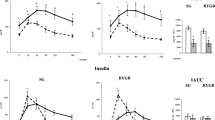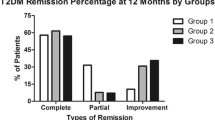Abstract
Background
Obesity is a major risk factor for the development of type 2 diabetes mellitus (T2DM). Insulin resistance (IR) is considered the pathologic link between T2DM and obesity. The mechanism in improving T2DM after bariatric surgery remains speculative. This trial assessed the effect of duodenal jejunal exclusion on the resolution of IR in gastric banding and gastric bypass procedures.
Methods
660 patients with complete biochemical and clinical data at baseline and at 3 years were selected for analysis. There were 197 males and 463 females. The mean age was 31.5 years (18–64) and mean BMI was 41.4 (32–77). There were 544 patients who received laparoscopic gastric bypass, and 116 patients received laparoscopic gastric banding. IR was measured by homeostatic model assessment (HOMA) index (HI), that can be calculated as HI = plasma glucose (mmol/l) × insulin (UI/ml)/22.5. HI was measured before surgery and 1, 3, 6, 12, 24, and 36 months after surgery.
Results
Of the 660 individuals, 517 (78.4%) had IR. The mean HI was 7.62 ± 13.13. The HI was correlated with BMI, waist circumference, insulin resistance, hyperlipidemia, inflammatory indicators, and abnormal liver enzymes. Before surgery, the HI was 7.92 ± 14.18 for the bypass group and 6.27 ± 6.47 for the banding group. After surgery, the HI began to lower in both groups, and this reduction was maintained during follow-up. At 36 months after surgery, mean percentage of excess weight loss (%EWL) was 70.5% for the bypass group and 41.9% for the banding group. The HI was 1.00 ± 0.79 for bypass and 1.51 ± 1.25 for banding. The bypass patients had a better and faster weight reduction, but the HI was similar between the two groups at the same weight reduction percentage.
Conclusion
IR is common in morbidly obese patients. Both gastric banding and gastric bypass are effective for the reverse of IR in these patients. It seems that the effect is related to the absolute weight loss rather than different surgical procedures. There is no duodenal jejunal exclusion effect on IR resolution was observed in this study.

Similar content being viewed by others
References
Must A, Spadano J, Coakley EH, et al. The disease burden associated with overweight and obesity. JAMA. 1999;282:1523–9.
Allison DB, Fontaine KR, Manson JE, et al. Annual deaths attributable to obesity in the United States. JAMA. 1999;284:1530–8.
Mokdad AH, Marks JS, Stroup DR, et al. Actual causes of death in the United States. 2000 JAMA. 2004;291:1238–45.
Jallut D, Golay A, Munger R, et al. Impaired glucose tolerance and diabetes in obesity: a 6-year follow-up study of glucose metabolism. Metabolism. 1990;39:1068–75.
Panzram G. Mortality and survival in type 2 (non-insulin-dependent) diabetes mellitus. Diabetologia. 1998;30:123–31.
National Task Force on the Prevention and Treatment of Obesity. Overweight, obesity, and health risk. Arch Int Med. 2000;160:898–904.
Matthews DR, Hosker JP, Rudensky AS, et al. Homeostasis model assessment: insulin resistance and B-cell function from fasting plasma glucose and insulin concentration in man. Diabetologia. 1985;28:412–9.
Pories WJ, Swanson MS, MacDonald KG, et al. Who would have thought it? An operation provides to be the most effective therapy for adult onset diabetes mellitus. Ann Surg. 1995;222:339–52.
Dixon JB, O’Brien PE. Health outcomes of severely obese type 2 diabetes subjects 1 year after laparoscopic adjustable gastric banding. Diabetes C. 2002;25:358–63.
Buchwald H, Avidor Y, Braunwald E, et al. Bariatric surgery: a systematic review and meta-analysis. JAMA. 2004;292:1724–37.
Gumbs AA, Modlin IM, Ballantyne GH. Changed in insulin resistance following bariatric surgery: role of caloric restriction and weight loss. Obes Surg. 2005;15:462–73.
Hickey MS, Pories WJ, MacDonald KG, et al. A new paradigm for type 2 diabetes mellitus. could it be a disease of the foregut? Ann Surg. 1998;227:637–44.
Greenway SE, Greenway EL, Klevin S. Effected of obesity surgery on non-insulin-dependent diabetes mellitus. Arch Surg. 2002;137:1109–17.
Rubino F, Gagner M, Gentileschi P, et al. The early effect of the Roux-en-Y gastric bypass on hormones involved in body weight regulation and glucose metabolism. Ann Surg. 2004;240:236–42.
Rubino F, Marescaux J. Effects of duodenal–jejunal exclusion in a non-obese animal model of type 2 diabetes: a new perspective for an old disease. Ann Surg. 2004;239:1–11.
Lee WJ, Wang W. Bariatric surgery: Asia-pacific perspective. Obes Surg. 2005;15:751–7.
Wang W, Wei PL, Lee YC, et al. Short-term results of laparoscopic mini-gastric bypass. Obes Surg. 2005;15:648–54.
Lee WJ, Wang W, Yu PJ, et al. Gastrointestinal quality of life following laparoscopic adjustable gastric banding in Asia. Obes Surg. 2006;16:586–91.
Doar JW, Wilde CE, Thompson ME, et al. Influence of treatment with diet alone on oral glucose-tolerance test and plasma sugar and insulin levels in patients with maturity onset diabetes mellitus. Lancet. 1975;1(7919):1263–6.
Kelly DE, Wing R, Buonocore C, et al. Relative effect soft calorie restriction and weight loss in non-insulin-dependent diabetes mellitus. J Clin Endocrinol Metab. 1993;77:1287–93.
Ash S, Reeves MM, Yeo S, et al. Effect of intensive dietetic interventions on weight and glycemic control in overweight men with type II diabetes: a randomized trial. Int J Obes. 2003;27:797–802.
Tuomilehto J, Lindstrom J, Eriksson JG, et al. Prevention of type 2 diabetes mellitus by changes in lifestyle among subjects with impaired glucose tolerance. NEJM. 2001;344:1343–50.
Harder H, Dinesen B, Astrup A. The effect of rapid weight loss on lipid profile and glycemic control in obese type 2 diabetic patients. Int J Obes. 2004;28:180–2.
Lee WJ, Yu PJ, Wang W, et al. Laparoscopic Roux-en-Y versus mini-gastric bypass for the treatment of morbid obesity: a prospective randomized controlled clinical trial. Ann Surg. 2005;242:20–8.
Flum DR, Salem L, Elrod JAB, et al. Early mortality among medicare beneficiaries undergoing bariatric surgical procedures. JAMA. 2005;294:1903–8.
Lee WJ, Chen HH, Wang W, et al. Metabolic syndrome in obese patients referred for weight reduction surgery in Taiwan. J Formos Med Assoc. 2003;102:459–64.
Lee WJ, Huang MT, Wang W, et al. Effects of obesity surgery on metabolic syndrome. Arch Surg. 2004;139:1088–92.
Sjostrom L, Narbro K, Sjostrom D, et al. Effect of bariatric surgery on mortality in Swedish obese subjects. NEJM. 2007;357:741–52.
O’Brien PE, Dixon JB, Laurie, et al. Treatment of mild to moderate obesity with laparoscopic adjustable gastric banding or an intensive medical program. Ann Intern Med. 2006;144:625–33.
Author information
Authors and Affiliations
Corresponding author
Rights and permissions
About this article
Cite this article
Lee, WJ., Lee, YC., Ser, KH. et al. Improvement of Insulin Resistance After Obesity Surgery: A Comparison of Gastric Banding and Bypass Procedures. OBES SURG 18, 1119–1125 (2008). https://doi.org/10.1007/s11695-008-9457-3
Received:
Accepted:
Published:
Issue Date:
DOI: https://doi.org/10.1007/s11695-008-9457-3




